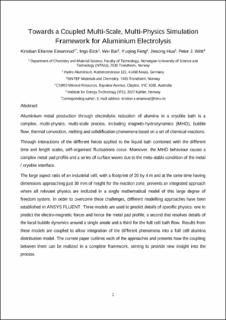Towards a coupled multi-scale, multi-physics simulation framework for aluminium electrolysis
Peer reviewed, Journal article
Submitted version
Permanent lenke
https://hdl.handle.net/11250/2719729Utgivelsesdato
2017Metadata
Vis full innførselSamlinger
- Publikasjoner fra CRIStin - SINTEF AS [5801]
- SINTEF Industri [1565]
Sammendrag
Aluminium metal production through electrolytic reduction of alumina in a cryolite bath is a complex, multi-physics, multi-scale process, including magneto-hydrodynamics (MHD), bubble flow, thermal convection, melting and solidification phenomena based on a set of chemical reactions. Through interactions of the different forces applied to the liquid bath combined with the different time and length scales, self-organised fluctuations occur. Moreover, the MHD behaviour causes a complex metal pad profile and a series of surface waves due to the meta-stable condition of the metal/cryolite interface. The large aspect ratio of an industrial cell, with a footprint of 20 by 4 m and at the same time having dimensions approaching just 30 mm of height for the reaction zone, prevents an integrated approach where all relevant physics are included in a single mathematical model of this large degree of freedom system. In order to overcome these challenges, different modelling approaches have been established in ANSYS® FLUENT®; Three models are used to predict details of specific physics: one to predict the electro-magnetic forces and hence the metal pad profile, a second that resolves details of the local bubble dynamics around a single anode and a third for the full cell bath flow. Results from these models are coupled to allow integration of the different phenomena into a full cell alumina distribution model. The current paper outlines each of the approaches and presents how the coupling between them can be realized in a complete framework, aiming to provide new insight into the process.
